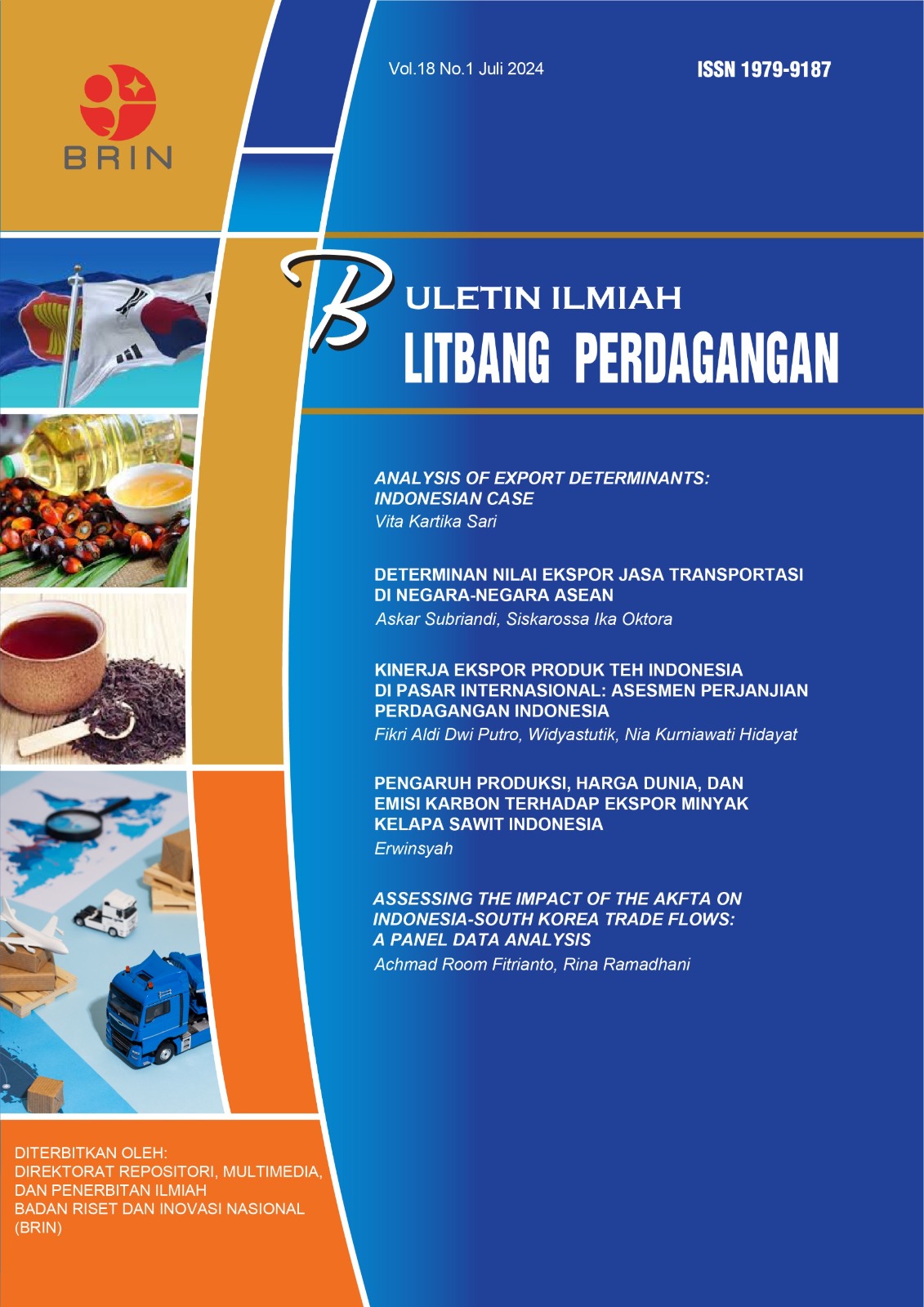Analysis of Determinants: Indonesian Case
DOI:
https://doi.org/10.55981/bilp.2024.3515Keywords:
exchange rate, exports, foreign direct investment, inflation, GDP per capitaAbstract
Exports directly impact national income, which will also have implications for increasing levels of productivity, innovation, and technology transfer. The urgency of exports from an open economic perspective is to increase the capacity for economic growth. Unfortunately, various factors often hinder export performance, disrupting the potential benefits. The main objective of this study is to analyze the impact of macroeconomic variables, namely the exchange rate, foreign direct investment (FDI), Gross Domestic Product (GDP) per capita, and inflation on Indonesian exports in the period 1970-2022. This research uses time series data with the Autoregressive Distributed Lag-Error Correction Model (ARDL-ECM) method. The findings of the analysis show that the exchange rate, FDI, GDP per capita, and inflation have a positive and significant effect on exports in the long term. Therefore, if the Indonesian government wants to maintain its trade balance, it is recommended to keep a floating and controlled exchange rate policy and coordinate pro-export-oriented investment policies.
Downloads
References
Abidin, I. S. Z., Bakar, N. A., & Sahlan, R. (2013). The determinants of exports between Malaysia and the OIC member countries: A gravity model approach. Procedia Economics and Finance, 5(13), 12–19. https://doi.org/10.1016/s2212-5671(13)00004-x.
Aghion, P., Bacchetta, P., Ranciere, R., & Rogoff, K. (2009). Exchange rate volatility and productivity growth: The role of financial development. Journal of Monetary Economics, 56(4), 494–513. https://doi.org/10.1016/j.jmoneco.2009.03.015.
Agosin, M., & Díaz, J. D. (2023). Explaining the volatility of the real exchange rate in emerging markets. International Review of Economics and Finance, 87(April), 110–123. https://doi.org/10.1016/j.iref.2023.04.024.
Akbas, Y. E., & Sancar, C. (2021). The impact of export dynamics on trade balance in emerging and developed countries : An evaluation with middle income. International Review of Economics and Finance, 76(August 2020), 357–375. https://doi.org/10.1016/j.iref.2021.06.014.
Balassa, B. (1985). Exports, policy choices, and economic growth in developing countries after the 1973 oil shock. Journal of Development Economics, 18(1), 23–35. https://doi.org/https://doi.org/10.1016/0304-3878(85)90004-5.
Bank Indonesia. (2023). Tinjauan kebijakan moneter agustus 2023. Jakarta: Bank Indonesia.
Bush, G., & Noria, G. L. (2021). Uncertainty and exchange rate volatility: Evidence from Mexico. International Review of Economics and Finance, 75, 704–722. https://doi.org/https://doi.org/10.1016/j.iref.2021.04.029.
Dritsaki, C., & Stiakakis, E. (2014). Foreign direct investments, exports, and economic growth in Croatia : A time series analysis. Procedia Economics and Finance, 14(1992), 181–190. https://doi.org/10.1016/S2212-5671(14)00701-1.
Dubas, J. M., Lee, B.-J., & Mark, N. C. (2005). Effective exchange rate classifications and growth. National Bureau of Economic Research Working Paper Series, Report No. http://www.nber.org/papers/w11272.
Ebadi, A., & Ebadi, A. (2015). How the export volume is affected by determinant factors in a developing country?. Research in World Economy, 6(1), 143–150. https://doi.org/10.5430/rwe.v6n1p143.
Ginting, A. M. (2013). The influence of exchange rate on Indonesia’s exports. Buletin Ilmiah Litbang Perdagangan, 7(1), 1–18. https://jurnal.kemendag.go.id/bilp/article/download/96/61/.
Goldstein, M., & Khan, M. (1985). Income and price effects in foreign trade. Handbook of International Economics, 2, pp 1041-1105. https://www.worldscientific.com/doi/pdf/10.1142/9789814749589_0001.
Herrera-echeverri, H., Nandy, D. K., & Fragua, D. (2022). The role of private equity investments on exports : Evidence from OECD countries. Journal of Multinational Financial Management, 65(March), 100739. https://doi.org/10.1016/j.mulfin.2022.100739.
Jara, A., & Piña, M. (2023). Exchange rate volatility and the effectiveness of FX interventions: The case of Chile. Latin American Journal of Central Banking, 4(2), 1-20. https://doi.org/10.1016/j.latcb.2023.100086.
Kuznets, S. (1955). Economic growth and income inequality. The American Economic Review, 1(1), 1–28. https://www.jstor.org/stable/1811581.
Liming, C., Ziqing, D., & Zhihao, H. (2020). Impact of economic policy uncertainty on exchange rate volatility of China. Finance Research Letters, 32(109), 1–5. https://doi.org/10.1016/j.frl.2019.08.014.
Majumder, S. C., Rahman, M. H., & Martial, A. A. A. (2022). The effects of foreign direct investment on export processing zones in Bangladesh using generalized method of moments approach. Social Sciences and Humanities Open, 6(1), 100277. https://doi.org/10.1016/j.ssaho.2022.100277.
Mankiw, N.G. (2003). Macroeconomics. USA: Worth Publishers.
Maza, A., & Gutiérrez-Portilla, P. (2022). Outward FDI and exports relation: A heterogeneous panel approach dealing with cross-sectional dependence. International Economics, 170(March), 174–189. https://doi.org/10.1016/j.inteco.2022.04.002.
Melvin, M. (1985). The choice of an exchange rate system and macroeconomic stability. Journal of Money, Credit and Banking, 17(4), 467–478. https://doi.org/10.2307/1992442.
Narayan, B., Kumar, P., & Syarifuddin, F. (2022). Understanding the role of trade agreements in Indonesia’s FDI. Journal of Asian Economics, 82(August 2021), 101532. https://doi.org/10.1016/j.asieco.2022.101532.
Narayan, S., & Bhattacharya, P. (2019). Relative export competitiveness of agricultural commodities and its determinants: Some evidence from India. World Development, 117, 29–47. https://doi.org/10.1016/j.worlddev.2018.12.013.
Nguyen, T. H. (2016). Impact of export on economic growth in Vietnam: Empirical research and recommendations. International Business and Management, 13(3), 45–52. https://doi.org/10.3968/9040.
Pesaran, M. H., Shin, Y., & Smith, R. J. (2001). Bounds testing approaches to the analysis of level relationships. Econometrics, Journal of Applied, 16(3), 289–326. https://doi.org/https://doi.org/10.1002/jae.616.
Ramoni-Perazzi, J., & Romero, H. (2022). Exchange rate volatility, corruption, and economic growth. Heliyon, 8(12). https://doi.org/10.1016/j.heliyon.2022.e12328.
Riedel, J. (1975). The nature and determinants of export-oriented direct foreign investment in a developing country: A case study of Taiwan. Review of World Economics, 111(3), 505–528. https://doi.org/10.1007/BF02696445.
Sabaruddin, S. S. (2016). Determinant analysis of bilateral trade between Indonesia and Yemen during the period 1990-2015: A gravity model approach. Journal of Developing Economies, 1(2), 107-121. https://doi.org/10.20473/jde.v1i2.3296.
Sarwedi, S. (2010). Determinant analysis of supply change of Indonesia’s export product. Buletin Ekonomi Moneter Dan Perbankan, 12(3), 329–348. https://doi.org/10.21098/bemp.v12i3.375.
Shahzad, U., Madaleno, M., Dagar, V., Ghosh, S., & Doğan, B. (2022). Exploring the role of export product quality and economic complexity for economic progress of developed economies: Does institutional quality matter?. Structural Change and Economic Dynamics, 62, 40–51. https://doi.org/https://doi.org/10.1016/j.strueco.2022.04.003.
Shetewy, N., Shahin, A. I., Omri, A., & Dai, K. (2022). Impact of financial development and internet use on export growth: New evidence from machine learning models. Research in International Business and Finance, 61, 101643. https://doi.org/https://doi.org/10.1016/j.ribaf.2022.101643.
Suárez-porto, V., & Guisado-gonzález, M. (2014). Analysis of the determinants of exporting intensity in the field of innovation. Investigaciones Europeas de Dirección y Economía de La Empresa, 20(2), 79–86. https://doi.org/10.1016/j.iedee.2013.12.002.
Syaputra, I. A., & Laut, L. T. (2022). Determinasi ekspor Indonesia tahun 1990-2021. Growth: Jurnal Ilmiah Ekonomi Pembangunan, 1(2), 22–42. https://stiemmamuju.e-journal.id/GJIEP/article/view/94/50.
Szkorupová, Z. (2014). Emerging markets queries in finance and business: A causal relationship between foreign direct investment, economic growth and export for Slovakia. Procedia Economics and Finance, 15(14), 123–128. https://doi.org/10.1016/S2212-5671(14)00458-4.
Wang, X., Qi, Z., & Huang, J. (2023). How do monetary shock, financial crisis, and quotation reform affect the long memory of exchange rate volatility? Evidence from major currencies. Economic Modelling, 120, 106155. https://doi.org/https://doi.org/10.1016/j.econmod.2022.106155.
Xiong, T. (2022). The Effect of bilateral investment treaties (BITs) on the extensive and intensive margins of exports. The Quarterly Review of Economics and Finance, 84, 68–79. https://doi.org/https://doi.org/10.1016/j.qref.2022.01.003.
Zaman, M., Pinglu, C., Irshad, S., Ullah, A., & Qian, N. (2021). Does regional integration matter for sustainable economic growth ? Fostering the role of FDI, trade openness, IT exports, and capital formation in BRI countries. Heliyon, 7(August), e08559. https://doi.org/10.1016/j.heliyon.2021.e08559.
Downloads
Published
How to Cite
Issue
Section
License
Copyright (c) 2024 vita kartika sari

This work is licensed under a Creative Commons Attribution-ShareAlike 4.0 International License.




 Buletin Ilmiah Litbang Perdagangan
Buletin Ilmiah Litbang Perdagangan